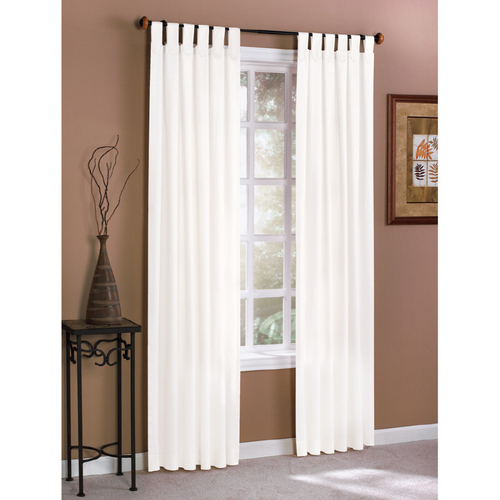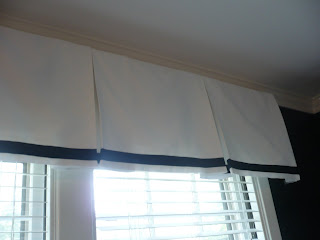Being that I had already sewn valances for the family room earlier this year and didn't like them, I knew that my husband would not be thrilled that I was making new ones quite so soon. So...I thought that I should impress him by economizing. (We'll see if it works!) I decided on white, box-pleat valances with navy grosgrain trim (for my family room renovation) and began shopping around for white fabric. I found some great fabrics and prices, but I was going to need a good bit of fabric and trim. In the June issue of House Beautiful, there is an article entitled "101 Finds From the Hardware Store." In fact, it was in this article that I saw the Lucite pulls (from Lowe's) that I used on the dresser in the nursery. The same article listed White Twill Curtains (Panels) from Lowe's for $11!! That is, $11 for a 84 L x 40 W panel. That is far less expensive than any fabric I had seen. After taking some measurements, I decided that two panels would provide enough fabric to create a large box-pleat valance for a set of two windows. I have five windows needing 3 valances total.
Go to Lowe's and purchase a 4 x 1 x ______ (length of board) inch board. You will likely want the board to extend a few inches past your window on both sides.
These curtains are VERY easy to sew. You will need to sew only a few straight lines though you will need to do some measuring and pressing. If you windows are more of a standard size, one panel will likely suffice for one window. You needn't be limited to shopping at Lowe's for panels. I think you could find panels at Target, Walmart, Bed, Bath and Beyond or any big-box store that would work for this project. Make sure that the panels are all the same color though. I had to return several panels to Lowe's that were obviously not manufactured in the same lot, so the color was slightly off.
You will be folding the panel in half, which will provide you with your face fabric (front fabric) and your lining (back fabric). Make sure you are comfortable with the thickness and weight of the fabric. The panels from Lowe's are white "twill" and the weight and thickness worked perfectly for this project. You need a fairly sturdy fabric for box pleats--something like silk or a gauzy fabric is not going to work well. It needs structure.
I will provide a tutorial of how I made a valance for a single window, but if you want a more specific and "proper" tutorial, this is a good one: http://www.diyideas.com/howto/sewing-fabric/boxvalance_1.html
Here are the materials you'll need:
- Lowe's panel 40x84
- seam ripper
- measuring tape/yard stick
- thread, pins, scissors
- trim or ribbon, if applicable
- iron
- L-brackets
- 4x1x____ inch board
- staple gun and staples
- screws and screwdriver
seam ripper
If applicable to your panel: Use a seam ripper, to rip the seams that attach the tabs to your curtains. (The panels that I purchased from Lowe's were "tab-top"), so I needed to remove the tabs in order to get my flat piece of "fabric."
Regardless of the style you'll need your panels to lie flat and not have any pleating, tabs, etc. You want a flat panel that looks like one big piece of rectangular fabric; however, do not remove the regular seams! You want to keep those because they are one less thing you have to sew! If you have tabs, you'll need to rip where the tabs are sewn to the outside of the panel and where the tabs are sewn into the panel. Afterwards, pin the areas back into place and sew a straight line--following the original seam--to close the areas where the tabs were sewn into the panels.
.
Once you have a large, flat panel. Give it a good press with the iron.
Then lay it flat on the floor. Fold it so that the side hems line up. Pin the side hems together. Then press the entire folded piece making a nice crisp edge that will be the bottom of the curtain.
Tip: Iron "down" the curtain. That is iron the fabric down towards the bottom fold away from the top hem and pins. This will help to avoid the fabric bunching or being distributed unevenly.
If applicable, now is the time to attach the trim. If you are making a proper valance, you wouldn't want the thread attaching the trim to be seen on the backside (lining) of the curtain; however, since these are "easy" valances, I didn't worry about this. Here is what I did:
Decide the distance between the bottom edge of the valance and your trim. To simplify matters, I used a 1 inch margin. Then, pin your trim at this distance all the way across the bottom of your valance. Be sure that a few inches of extra trim hangs over the edges....
Tip: Be sure to smooth your trim as you go. Make sure it is completely flat. I had to go back and re-pin a section because I was worried that it would bunch when I sewed it to the fabric.
Take the extra trim that is hanging-over the edges and fold it several times so that the raw edges are enclosed in the trim and pin the over hand to the backside (lining) of the curtain. See pictures:
Now it is time to sew your trim to the curtain. I did not use a zipper foot, but used the regular foot. Sew as closely to the edge of the trim as possible and, of course, use a thread that matches the trim.
The final step sewing step is creating the pleats. Don't be intimidated by this. In the most basic sense, you are making folds in a large piece of fabric until it fits nicely onto your pre-cut board. I took an approximately 84 inch piece of fabric and folded it until it fit a 42 inch board.
Start by marking the half-way point on your board. In my case 21 inches.
Next, use a pin to make the half-way point of your fabric. In my case 42 inches. At this point, it may help to look online or in your house at pleated curtains or upholstery so that you can understand how the pleats work.
Make your center pleat by folding the fabric behind itself on both sides, see pictures. Try to make each fold about the same size, like 4 inches:
Fold the fabric behind the half-way point on both sides making sure both folds in the pleat are about equal and make sure that the fold measures the same at the top and bottom of the curtain:
Once you are satisfied that the pleats are even, pin them in place:
Remember to ensure that your grosgrain or trim, if applicable, is lining up properly.
After you have securely pinned your pleats, it is time to sew the top of the valance. I followed the seam already made in the curtains (about a 1 inch seam allowance) and just sewed straight across the top of the valance sewing the pleats into place. See picture below:
(Sewing pleats into place)
Before you move onto the final step, you will want to press these curtains--well. They are supposed to look crisp, so you will want to press them straight and press the pleats to be crisp.
The final step--not including mounting--is stapling the curtains to the board. I always find this the most exciting part! It is the last step for me as my husband is the one that mounts the valances to the L-brackets and hangs the treatments.
Start by lining up the middle pleat to the middle of the board and begin stapling. Staples come in a variety of sizes and you will need longer staplers to go through the pleated fabric and secure the curtains to the board.
As for the corners, these are a bit trickier. Put your board on an ottoman or coffee table. I have my three-year-old sit on the middle to hold down the board, and I let the end of the board hang off the end of the ottoman. You want your pleat to fall right at the corner of the board. I apologize for not having more pictures...
Mount your L-brackets and hang your valances from them. We mounted the L-brackets to high--leaving just enough room for the board between the bracket and the molding--that I didn't even need to secure the valances. I just slid them into the space.
As you can see the, initially the side pleats are flying-out a bit to the side....
So, I used pins to make the pleats more structured:
I also made valances for my double windows. The only difference in the process is that I sewed two panels together at the ends to make the fabric 40 x 168 and made three pleats in the front of each in addition to the two side pleats:
I did not save my receipts, but here is the estimated cost for my valances which covered five windows:
$55 for fabric (5 white twill panels from Lowe's)
$17 for my navy grosgrain trim (on sale at Ben Franklin)
$15 approximate cost of wooden boards
$0 for l-brackets, staples, thread, etc. which were supplies that I already had
______________________________
$87 for five custom valances!
In the world of custom curtains, I can safely say this is a deal. It did take some time, but I believe it was well worth it.
xo-
Carson


















































